Texas Team Tournament
20th Anniversary Scenario Pack
For the past 20 years, the Texas ASL Club has hosted the Texas Team Tournament. The tournament has grown up over the years, and now draws players from all over the world. These scenarios were designed by some of our past participants, and offer a great range of tourney-sized scenarios.
Packs are now only available from The Gamer's Armory.
TX1: Beware the Hare
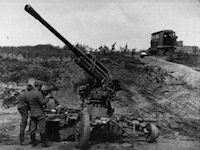 Pugacheny, Romania 10 May, 1944: During April 1944 a
series of attacks by the Red Army in the Iasśi sector was aimed at capturing the strategically important region.
The German and Romanian forces successfully defended throughout the month of April. The attack aiming at Targul
Frumos was the final attempt by the Red Army to achieve its goal of having a springboard into Romania for a summer
offensive. Before they could establish any initiative, the Germans counterattacked with reserve Panzer Divisions.
● Pete Shelling
Pugacheny, Romania 10 May, 1944: During April 1944 a
series of attacks by the Red Army in the Iasśi sector was aimed at capturing the strategically important region.
The German and Romanian forces successfully defended throughout the month of April. The attack aiming at Targul
Frumos was the final attempt by the Red Army to achieve its goal of having a springboard into Romania for a summer
offensive. Before they could establish any initiative, the Germans counterattacked with reserve Panzer Divisions.
● Pete Shelling
TX2: Last Gasp of the Wacht Am Rhein!
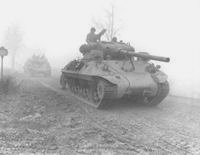 30km North of the Ardennes, 1 January, 1945: On 16
December, 1944, the Germans launched Operation Wacht am Rhein with the objective of splitting the allied armies and
capturing the port of Antwerp. By 24 December, the German advance was effectively stalled due to stubborn American
resistance and the outrunning of their supply lines. The bad terrain and weather encountered in the Ardennes reduced
the mileage gained from fuel by one-half; there was an expectation that the spearheads would move in part on captured
gasoline. In an effort to regain the initiative, on 1 January, German Army Group G and Army Group Upper Rhine
launched the last major German offensive of the war on the Western Front against the thinly stretched, 70-mile line
of the Seventh U.S. Army. This offensive was known as Operation Nordwind. In the German effort to acquire their
needed fuel supplies, one such depot was within reach of several German armored units. Under the cover of cloudy
skies and low level fog, an all-or-nothing thrust was made with barely enough fuel to reach the depot. The Americans
learned of the German plight and quickly sent a delaying action to thwart the Germans. ● Mike
Seningen
30km North of the Ardennes, 1 January, 1945: On 16
December, 1944, the Germans launched Operation Wacht am Rhein with the objective of splitting the allied armies and
capturing the port of Antwerp. By 24 December, the German advance was effectively stalled due to stubborn American
resistance and the outrunning of their supply lines. The bad terrain and weather encountered in the Ardennes reduced
the mileage gained from fuel by one-half; there was an expectation that the spearheads would move in part on captured
gasoline. In an effort to regain the initiative, on 1 January, German Army Group G and Army Group Upper Rhine
launched the last major German offensive of the war on the Western Front against the thinly stretched, 70-mile line
of the Seventh U.S. Army. This offensive was known as Operation Nordwind. In the German effort to acquire their
needed fuel supplies, one such depot was within reach of several German armored units. Under the cover of cloudy
skies and low level fog, an all-or-nothing thrust was made with barely enough fuel to reach the depot. The Americans
learned of the German plight and quickly sent a delaying action to thwart the Germans. ● Mike
Seningen
TX3: Ruined in a Day
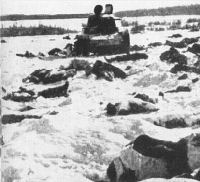 NNW of Stalingrad, 19 Nov 1942: While Paulus was mired
in the rubble that was Stalingrad, the Soviet plan was to tie down the front between the Don and the V olga. Near
Kletskaya, they would smash the Romanians on the left and thrust behind the army and cut its line of communications
across the Don. This would bring about the encirclement of the German 6th Army. By midnight of the 19th it had begun
to snow. Visibility was reduced to zero. In the wake of an hour-and-a-half-long artillery barrage, at 0850 hours,
Fifth Tank Army and the Twenty-first Army launched their assault against the Romanians. ● Mike
Seningen
NNW of Stalingrad, 19 Nov 1942: While Paulus was mired
in the rubble that was Stalingrad, the Soviet plan was to tie down the front between the Don and the V olga. Near
Kletskaya, they would smash the Romanians on the left and thrust behind the army and cut its line of communications
across the Don. This would bring about the encirclement of the German 6th Army. By midnight of the 19th it had begun
to snow. Visibility was reduced to zero. In the wake of an hour-and-a-half-long artillery barrage, at 0850 hours,
Fifth Tank Army and the Twenty-first Army launched their assault against the Romanians. ● Mike
Seningen
TX4: Corporal Punishment
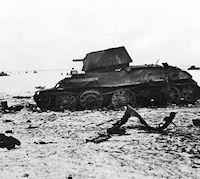 Kharkov, Russia, 7 February, 1943: As the Germans
fell back towards Kharkov, the Russians pressed hard their breakout from Stalingrad. The Germans desperately needed
time to reconstitute and rally their forces. Delaying elements were sacrificed in the field to slow down the Russian
advance and buy time for the main German forces. Penal Battalions were the perfect sacrificial units. They consisted
of a collection of criminals, POWs and soldiers caught at the wrong place at the wrong time. These soldiers opted to
serve in the penal battalion in lieu of facing the firing squad in hopes of proving their worth and regaining the
ability to return to their units and fight with the main elements. The 119th Penal Battalion was given the
opportunity to earn its freedom on the harsh steppes outside Kharkov. ● Mike Seningen
Kharkov, Russia, 7 February, 1943: As the Germans
fell back towards Kharkov, the Russians pressed hard their breakout from Stalingrad. The Germans desperately needed
time to reconstitute and rally their forces. Delaying elements were sacrificed in the field to slow down the Russian
advance and buy time for the main German forces. Penal Battalions were the perfect sacrificial units. They consisted
of a collection of criminals, POWs and soldiers caught at the wrong place at the wrong time. These soldiers opted to
serve in the penal battalion in lieu of facing the firing squad in hopes of proving their worth and regaining the
ability to return to their units and fight with the main elements. The 119th Penal Battalion was given the
opportunity to earn its freedom on the harsh steppes outside Kharkov. ● Mike Seningen
TX5: Rush Hour
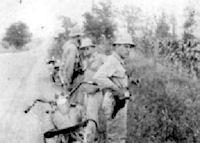 Martincourt, France, 2 September, 1944: On 1 September,
1944, the 80th Infantry Division moved east from Chalons towards the Meuse River. No enemy defensive line was
established, but organized resistance in the form of delaying actions by strong motorized patrols reinforced with
some self-propelled artillery was encountered. Bridgeheads across the Meuse River were quickly established and the
80th raced towards the Moselle River, quickly on the heels of retreating German forces. Cavalry patrols of the 80th
Recon Troop and Second Cavalry Squadron secured Mettancourt, Lahayecourt, and Mamey. On 2 September they entered
Martincourt. ● Mike Seningen
Martincourt, France, 2 September, 1944: On 1 September,
1944, the 80th Infantry Division moved east from Chalons towards the Meuse River. No enemy defensive line was
established, but organized resistance in the form of delaying actions by strong motorized patrols reinforced with
some self-propelled artillery was encountered. Bridgeheads across the Meuse River were quickly established and the
80th raced towards the Moselle River, quickly on the heels of retreating German forces. Cavalry patrols of the 80th
Recon Troop and Second Cavalry Squadron secured Mettancourt, Lahayecourt, and Mamey. On 2 September they entered
Martincourt. ● Mike Seningen
TX6: Tough Enough
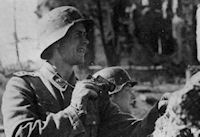 Facuti, Romania, 2 May, 1944: Spring of 1944 found the Red
Army juggernaught in the foothills of the Carpathians and all of Germany's allies in Eastern Europe were now in
danger. The ebb of the rasputitsa made mechanized operations possible and on April 25th, Konev's 2nd Tank Army moved
across the Romanian border with the objective of Iassy. German and Romanian forces defended well enough to buy time
for their own armored reserves to move into position around the town of Targul Frumos. There, the Panzergrenadier
Division Grossdeustschland met Konev's tanks in the mud of May's thaw. ● Pete Shelling
Facuti, Romania, 2 May, 1944: Spring of 1944 found the Red
Army juggernaught in the foothills of the Carpathians and all of Germany's allies in Eastern Europe were now in
danger. The ebb of the rasputitsa made mechanized operations possible and on April 25th, Konev's 2nd Tank Army moved
across the Romanian border with the objective of Iassy. German and Romanian forces defended well enough to buy time
for their own armored reserves to move into position around the town of Targul Frumos. There, the Panzergrenadier
Division Grossdeustschland met Konev's tanks in the mud of May's thaw. ● Pete Shelling
TX7: Hit and Run
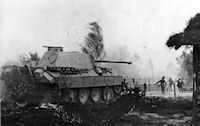 South of Baranov, Poland, 6 August 1944: The 24th Panzer
Division had been one of the ill-fated units trapped and destroyed in the Stalingrad debacle in 1943. But many of the
commanders and veteran cadres had been flown out of the stricken city to rebuild the unit. In the summer of 1944, the
rebuilt division was again witness to a looming military disaster. The annihilation of Army Group Center had left a
gaping hole in the middle of the German line. As the German high command scrambled to find units to fill the hole,
Koniev's 1st Ukrainian Front surged into eastern Poland unopposed. While the German 17th Army hastily detrained in
Cracow, the 24th Panzer Division moved into position to face the oncoming Russian giant alone. ● Dan
Preston
South of Baranov, Poland, 6 August 1944: The 24th Panzer
Division had been one of the ill-fated units trapped and destroyed in the Stalingrad debacle in 1943. But many of the
commanders and veteran cadres had been flown out of the stricken city to rebuild the unit. In the summer of 1944, the
rebuilt division was again witness to a looming military disaster. The annihilation of Army Group Center had left a
gaping hole in the middle of the German line. As the German high command scrambled to find units to fill the hole,
Koniev's 1st Ukrainian Front surged into eastern Poland unopposed. While the German 17th Army hastily detrained in
Cracow, the 24th Panzer Division moved into position to face the oncoming Russian giant alone. ● Dan
Preston
TX8: House of Cards
 Grünewalde, Germany, 14 April, 1945: As the American
Army closed in on the Elbe River in the spring of 1945, the race to be the first division into Berlin was intense. At
Barby, the 83rd Infantry Division had arrived to find the bridge blown but no opposition. Meanwhile, 15 miles
northwest at the town of Westerhüsen, the 2nd Armored Division had also established a bridgehead. On the night of 13
April, 3 infantry battalions had quietly crossed the river on DUKWs and formed a perimeter around the bridging site.
Bridging equipment was immediately brought up. But constant German shelling had so damaged and disrupted the site
that no armor or artillery could be taken across until a bridge was rebuilt. Brigadier General Sidney R. Hinds,
commander of Combat Command B, fretted that without heavy support, the bridgehead could easily be erased by a German
armored counterattack. Around dawn on Saturday the 14th, German artillery obliterated what was left of the bridge
site. Simultaneously, German tanks appeared all around the American perimeter. ● Dan Preston
Grünewalde, Germany, 14 April, 1945: As the American
Army closed in on the Elbe River in the spring of 1945, the race to be the first division into Berlin was intense. At
Barby, the 83rd Infantry Division had arrived to find the bridge blown but no opposition. Meanwhile, 15 miles
northwest at the town of Westerhüsen, the 2nd Armored Division had also established a bridgehead. On the night of 13
April, 3 infantry battalions had quietly crossed the river on DUKWs and formed a perimeter around the bridging site.
Bridging equipment was immediately brought up. But constant German shelling had so damaged and disrupted the site
that no armor or artillery could be taken across until a bridge was rebuilt. Brigadier General Sidney R. Hinds,
commander of Combat Command B, fretted that without heavy support, the bridgehead could easily be erased by a German
armored counterattack. Around dawn on Saturday the 14th, German artillery obliterated what was left of the bridge
site. Simultaneously, German tanks appeared all around the American perimeter. ● Dan Preston
TX9: Hell Freezes Over
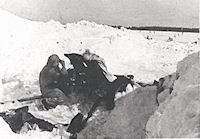 Panovo, Russia, 14 December, 1941: As Operation Typhoon
ground to a halt and the brutal Russian winter closed in, the German army was left in a position of extreme peril at
the gates of Moscow. Strung out and suffering from heavy casualties, the Germans were in no position to deal with the
cold and the Russian counteroffensive that was brewing. The German generals pleaded with Hitler to withdraw their
frostbitten and exhausted troops to more defensible locations. Hitler forbade retreat, but authorized consolidation
into defensive positions. The decision came not a moment too soon. Even as the Germans were digging in, ST A VKA was
positioning tough and specially equipped Siberian troops and armor for the counteroffensive. Among the positions the
Germans were determined to hold was the highway bridge near the town of Panovo. Partially destroyed during Operation
Typhoon, the town still provided the Germans with cover. Grim and shivering infantry of the 3rd Motorized Rifle
Regiment hunkered down in the frozen, burnt-out rubble and waited for the Russians to appear. ● Dan
Preston
Panovo, Russia, 14 December, 1941: As Operation Typhoon
ground to a halt and the brutal Russian winter closed in, the German army was left in a position of extreme peril at
the gates of Moscow. Strung out and suffering from heavy casualties, the Germans were in no position to deal with the
cold and the Russian counteroffensive that was brewing. The German generals pleaded with Hitler to withdraw their
frostbitten and exhausted troops to more defensible locations. Hitler forbade retreat, but authorized consolidation
into defensive positions. The decision came not a moment too soon. Even as the Germans were digging in, ST A VKA was
positioning tough and specially equipped Siberian troops and armor for the counteroffensive. Among the positions the
Germans were determined to hold was the highway bridge near the town of Panovo. Partially destroyed during Operation
Typhoon, the town still provided the Germans with cover. Grim and shivering infantry of the 3rd Motorized Rifle
Regiment hunkered down in the frozen, burnt-out rubble and waited for the Russians to appear. ● Dan
Preston
TX10: The Middle of Nowhere
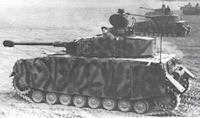 North of Losovaya, Russia, 6 March, 1943: Following the
surrender of 6th Army at Stalingrad, the massive Russian armies poised on the Don River struck out across the steppe
against the Italian 8th and Hungarian 2nd Armies. The unprepared defenders crumpled under the onslaught of wave after
wave of tanks and infantry. The Germans were compelled to evacuate Kharkov. The Russians, flushed with victory from
their initial success, drove deep into the German rear, nearing the HQ of Field Marshal Manstein at Zaporozhe. Hitler
had initially demanded the recapture of Kharkov but Manstein had patiently explained his strategy to the Führer.
Holding firm north of the penetration, Army Group Kempf had been reinforced by the Grossdeutschland Panzergrenadier
Division. South of the gap, 4th Panzer Army, consisting of two panzer corps, calmly allowed the Russian masses to
stream past and waited for the order to attack. On the 22nd of February, 4th Panzer Army moved out across the bleak,
snowy steppe; the trap was sprung. ● Dan Preston
North of Losovaya, Russia, 6 March, 1943: Following the
surrender of 6th Army at Stalingrad, the massive Russian armies poised on the Don River struck out across the steppe
against the Italian 8th and Hungarian 2nd Armies. The unprepared defenders crumpled under the onslaught of wave after
wave of tanks and infantry. The Germans were compelled to evacuate Kharkov. The Russians, flushed with victory from
their initial success, drove deep into the German rear, nearing the HQ of Field Marshal Manstein at Zaporozhe. Hitler
had initially demanded the recapture of Kharkov but Manstein had patiently explained his strategy to the Führer.
Holding firm north of the penetration, Army Group Kempf had been reinforced by the Grossdeutschland Panzergrenadier
Division. South of the gap, 4th Panzer Army, consisting of two panzer corps, calmly allowed the Russian masses to
stream past and waited for the order to attack. On the 22nd of February, 4th Panzer Army moved out across the bleak,
snowy steppe; the trap was sprung. ● Dan Preston
